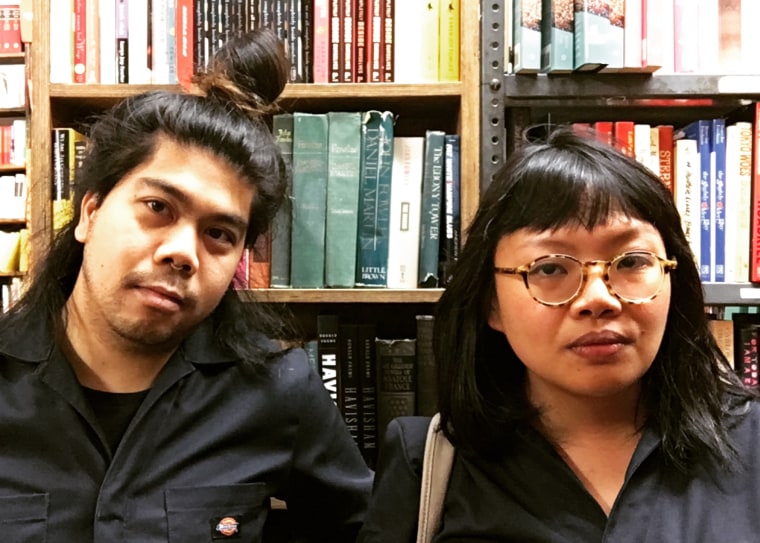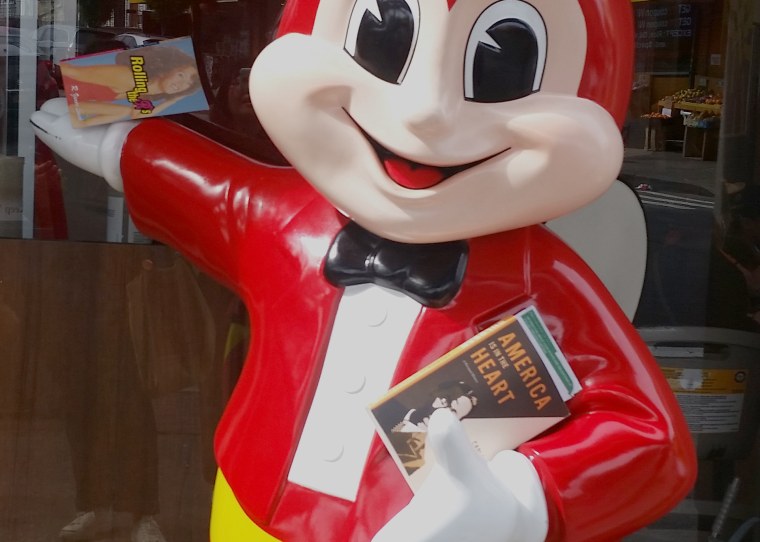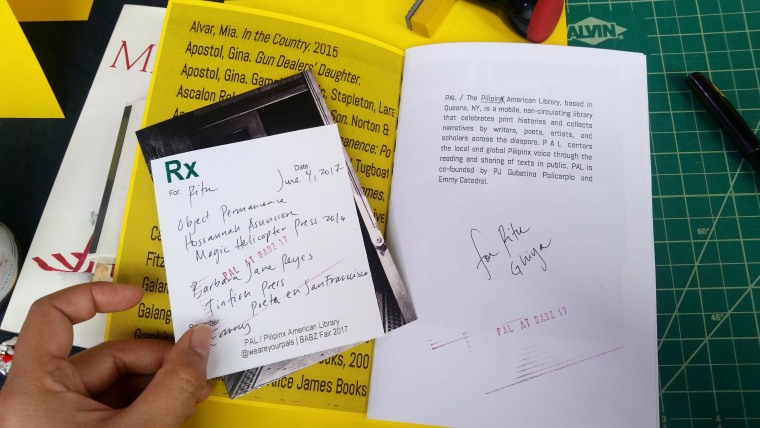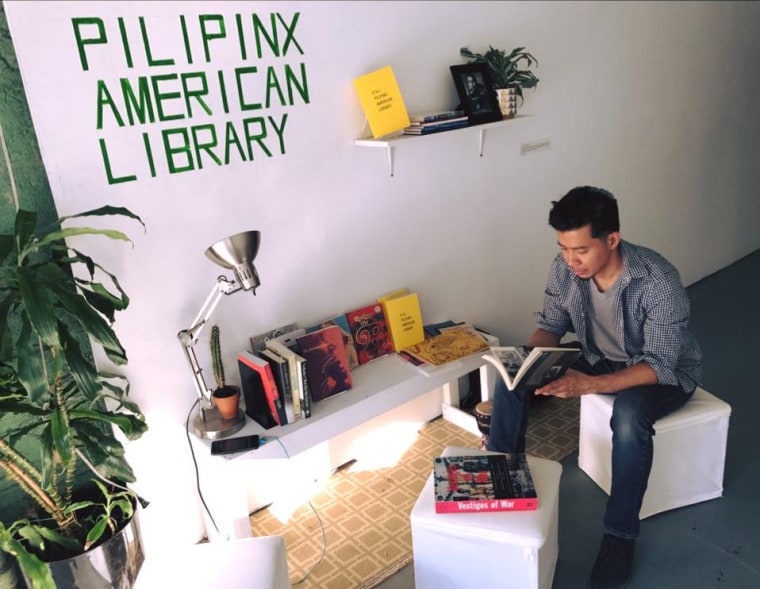When the Queens Museum in New York asked P.J. Policarpio to organize an event to engage the Filipino-American community last June, the artist cold-emailed every writer he could think of for a book festival.
“Everybody showed up,” Policarpio recalled.
Authors — including Mia Alvar, Ninotchka Roska, and Gina Apostol — gave readings of their work, which were then put on display. Policarpio also contributed books from his own collection. By his measure, the event was a success.
“The response was really positive, enthusiastic,” Polcarpio said. “A lot of people came, a lot of bystanders came and looked and flipped and read.”
“People are like, ‘Oh there are Filipino writers? There’s Filipino literature?’ People can go their entire lives without reading Filipino literature that we were so fortunate to have.”
One of the attendees was Emmy Catedral, a fellow artist and Queens resident. She began helping Policarpio on the project, lending her own books to the collection. After the 2016 election, the two, both immigrants from the Philippines who lived in diverse neighborhoods, began discussing their collaboration in a new light.
What has resulted is the Pilipinx American Library (PAL), a pop-up of Filipino-American literature currently on display in New York, California, and online.
In addition to poetry and novels, PAL’s collection includes academic writing, art books, and zines — short self-published magazines.
For one of their first pop-ups at New York’s BABZ Fair in June, the pair centered their exhibition around what they said is widely regarded as the first Filipino-American novel, Carlos Bulosan’s “America is in the Heart,” which was first published in 1946.
Bulosan’s novel loosely mirrors the author’s own life. He writes about his immigration from the Philippines and describes the suffering of migrant laborers in the 1930s.
Policarpio and Catedral, who first encountered the book in high school and university classes respectively, had been thinking about the ongoing conversation about race in America and how to relate it to Filipino-American history. “America is in the Heart,” with its historic significance, seemed the perfect place to start.
“I think with PAL, Emmy and I were interested in charting a lineage, a timeline, for Filipino-American literature and voices,” said Policarpio. “His was the first widely published novel, but Filipinos have been in contact with the U.S. for centuries in different ways and different capacities.”

In addition to being one of the first Filipino-American literary voices, Bulosan also highlighted Filipino-American historical narratives with his work. Although Filipino Americans are the third-largest Asian group in the country according to the U.S. Census, Policarpio remarked that their place in history is largely invisible.
RELATED: Eclipsed by Cesar Chavez, Larry Itliong’s Story Now Emerges
He pointed to the Manong generation — “the early Filipino men who worked in the fields alongside Mexican Americans and Chinese Americans” — and the role that Filipino-American workers played in the labor movement — particularly during the Delano grape strike of the 1960s, after which they were joined by Cesar Chavez — as examples.
“For me, personally, that cultural and society amnesia and erasure is painful,” Policarpio said. “We talk about generational trauma but subsequent generations have not had the opportunity to learn that kind of history.”

PAL’s founders said it serves many functions: as a source of education, as a performance art piece, and as a conduit for discovering new writers and stories.
At BABZ Fair and at PAL’s other earlier showings at the Smithsonian’s Asian American Literature Festival and Long Island’s Flux Factory, Policarpio and Catedral wrote personalized “prescriptions” of readings for individuals who approached them for advice.
RELATED: Congressional Gold Medal for Filipino World War II Vets Is an Honor ‘75 Years in the Making’
Policarpio and Catedral said their readers have so far been a “mixed audience,” which the two love.
“It’s easy to do a lot of things making sure your community is represented but oftentimes it doesn’t have visibility beyond the community,” said Catedral. “It was important because the public nature of the library is all about creating instances of encountering the unexpected representations of what is, ultimately, an American story.”

Both are quick to acknowledge that PAL is not the first or only library of its kind. Catedral points to other collectives whose work she is inspired by, such as the Feminist Library on Wheels and the Free Black Women’s Library. PAL is currently showing alongside both as part of the 25 libraries invited by Wendy’s Subway Reading Room’s exhibit at the Brooklyn Academy of Music.
When they’re not showing at exhibitions, PAL has a “home on the Internet.” Policarpio noted that while this initially sparked some confusion from people who wanted to visit the library, PAL’s social media accounts allow them to interact with interested readers.
“It was important because the public nature of the library is all about creating instances of encountering the unexpected representations of what is, ultimately, an American story.”
“People are like, ‘Oh there are Filipino writers? There’s Filipino literature?’ People can go their entire lives without reading Filipino literature that we were so fortunate to have,” Policarpio said.
A longer term space or residency is a future goal, but for now, Policarpio and Catedral are enjoying popping up at exhibitions on both coasts, which allow them to curate to each show’s particular framework and interact with other groups.
They said they revel in creating programs that “trouble the text,” using books as starting points for larger conversations. They also are focused on building a community centered around Filipino narratives, making sure Filipino-American voices are heard and highlighting the nuances of their stories.
“If we’re going to think about [the Filipino-American community] as a single people, the complexity is what defines the culture,” Catedral said. “An embrace of how complicated things are. It’s what the library, I feel, is revealing.”
Follow NBC Asian America on Facebook, Twitter, Instagram and Tumblr.
